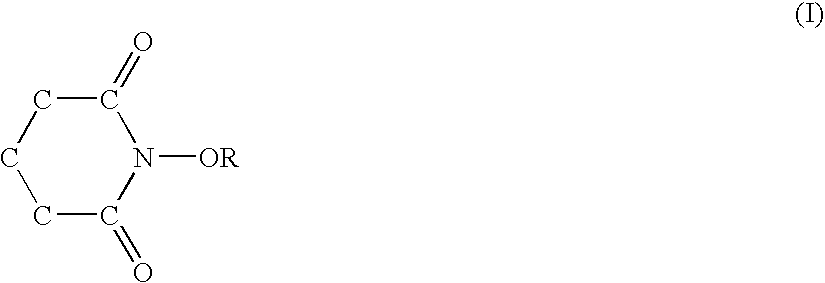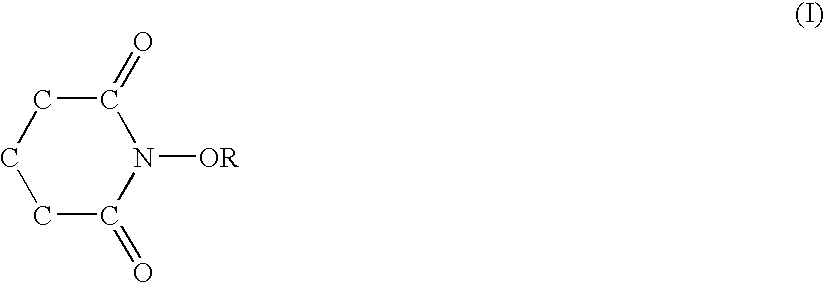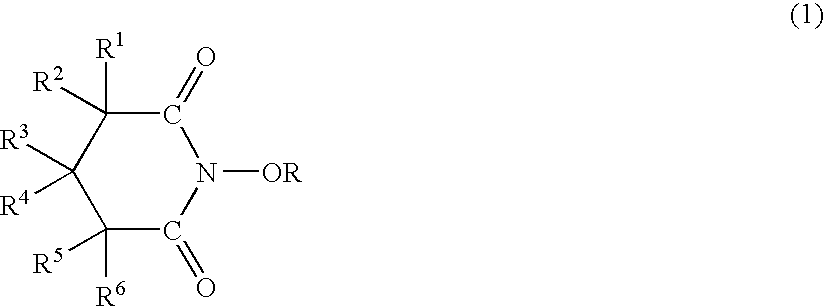Catalyst comprised of n-substituted cyclic imides and processes for preparing organic compounds with the catalyst
a technology of cyclic imides and catalysts, which is applied in the direction of organic compounds/hydrides/coordination complex catalysts, physical/chemical process catalysts, bulk chemical production, etc., can solve the problems of substrate decomposition, high temperature and/or high pressure, and the catalytic oxidation process cannot easily and efficiently produce alcohol or carboxylic acid under mild conditions. , to achieve the effect of high selectivity and high yield
- Summary
- Abstract
- Description
- Claims
- Application Information
AI Technical Summary
Benefits of technology
Problems solved by technology
Method used
Image
Examples
preparation example 1
[0305]Production of N-hydroxynaphthalimide
[0306]A 3-L flask equipped with a stirrer, cooling tube and thermometer was purged by nitrogen gas. 55.2 g (770 mmol) of hydroxylamine-hydrochloride (purity of 97%) and 1.2 L of pyridine were added to the flask and were stirred to dissolve at room temperature under nitrogen atmosphere. To the stirred mixture, 138.7 g (700 mmol) of 1,8-naphthalenedicarboxylic anhydride was added. The stirred mixture was heated at 40° C. for 1 hour and subsequently was heated at 70° C. for 1 hour. After stirring at 90° C. for 1 hour, the reaction mixture was cooled to room temperature with stirring. The resulting crystalline solid was filtered off and washed with 5% by weight of acetic acid aqueous solution and dried at 80° C. for 20 hours under a reduced pressure to yield 120.7 g (81%) of N-hydroxynaphthalimide with yellow color.
[0307]Spectral Data
[0308]1H-NMR (DMSO-d6, 500 MHz) δ: 7.8–8.0 (m, 2H, ArH), 8.4–8.6 (m, 4H, ArH), 10.74 (brs, 1H, OH)
[0309]13C-NMR (...
preparation example 2
[0311]Production of N-acetoxynaphthalimide (N-acetoxy-1,8-naphthalenedicarboximide)
[0312]A 1-L flask equipped with a stirring, cooling tube, thermometer and dropping funnel was purged by nitrogen gas. 80.0 g (375 mmol) of N-hydroxynaphthalimide obtained by preparation example 1 and 200 ml of acetic acid were added to the flask. The stirred mixture was heated at 60° C. under nitrogen atmosphere. To the resulting mixture, 76.7 g (750 mmol) of acetic anhydride was added dropwise for 20 minutes. After stirring at 110° C. for 1.5 hours, the reaction mixture was cooled to room temperature with stirring. The crystalline solid was filtered off and washed with acetic acid, and dried at 80° C. for 12 hours under a reduced pressure to yield 82.6 g (86%) of N-acetoxynaphthalimide with pale yellow color.
[0313]Spectral Data
[0314]1H-NMR (CDCl3, 500 MHz) δ: 2.48 (s, 3H, CH3), 7.7–7.8 (m, 2H, ArH), 8.2–8.3 (m, 2H, ArH), 8.5–8.7 (m, 2H, ArH)
[0315]13C-NMR (CDCl3, 125 MHz) δ: 166.6, 159.4, 135.0, 131.8...
preparation example 3
[0317]Production of N,N′-dihydroxy-1,8;4,5-naphthalenetetracarboxdiimide
[0318]A 5-L flask equipped with a stirrer, cooling tube and thermometer was purged by nitrogen gas. 110.3 g (1.54 mol) of hydroxylamine-hydrochloride (purity of 97%) and 2 L of pyridine were added to the flask and were dissolved with stirring at room temperature under nitrogen atmosphere. To the stirred mixture, 187.7 g (700 mmol) of 1,8;4,5-naphthalenetetracarboxylic dianhydride was added. The stirred mixture was heated at 40° C. for 1 hour and subsequently was heated at 70° C. for 1 hour. After stirring at 90° C. for 1 hour, the reaction mixture was cooled to room temperature with stirring. The precipitate was filtered off, washed with 5% by weight of acetic acid aqueous solution, and dried at 80° C. for 12 hours under a reduced pressure to yield 160.1 g (69%) of N,N′-dihydroxy-1,8;4,5-naphthalenetetracarboxdiimide with brown color.
[0319]Spectral Data
[0320]1H-NMR (DMSO-d6, 500 MHz) δ: 8.5–8.7 (m, 4H, ArH), 11....
PUM
| Property | Measurement | Unit |
|---|---|---|
| temperatures | aaaaa | aaaaa |
| pKa | aaaaa | aaaaa |
| atomic number | aaaaa | aaaaa |
Abstract
Description
Claims
Application Information
 Login to View More
Login to View More - R&D
- Intellectual Property
- Life Sciences
- Materials
- Tech Scout
- Unparalleled Data Quality
- Higher Quality Content
- 60% Fewer Hallucinations
Browse by: Latest US Patents, China's latest patents, Technical Efficacy Thesaurus, Application Domain, Technology Topic, Popular Technical Reports.
© 2025 PatSnap. All rights reserved.Legal|Privacy policy|Modern Slavery Act Transparency Statement|Sitemap|About US| Contact US: help@patsnap.com



